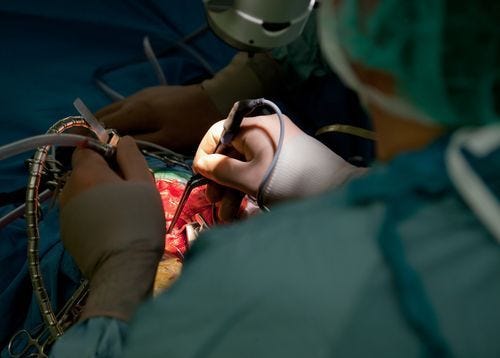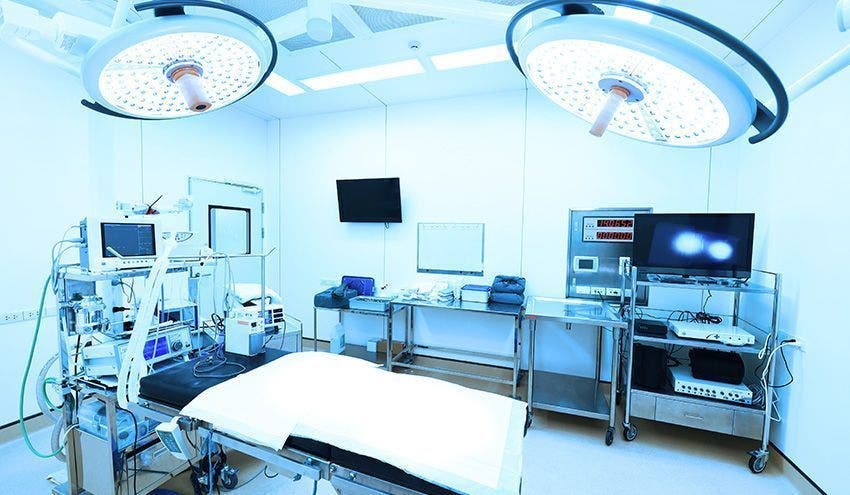While there are many different types of medical operations and procedures, there are a select few that prove to be extremely risky. Health Care Business compiled a list of the riskiest types of procedures to experience as a patient -- the following are the top 5.
1. Craniectomy
One of the riskiest, if not the riskiest medical operation an individual can experience is a craniectomy, according to URMC. Not to be confused with a craniotomy, which is very similar, a craniectomy is a neurosurgical procedure in which a patient has a piece of their skull removed using power tools like a drill and a mechanical saw.
A craniotomy is similar because it too involves removing a portion of the skull. However in a craniotomy the piece of skull is replaced after the operation is complete. A craniectomy has a higher level of risk than a craniotomy because the portion of the skull is not to be replaced for a good amount of time after the procedure is complete.
The procedure is usually a last-resort life saving measure and is generally needed to reduce swelling or bleeding around or within the brain. Depending on the extent of the injury the recovery process can take months to years, and unfortunately does not guarantee a full recovery status.

2. Surgical Ventricular Restoration
Heart attacks are a common occurrence across the globe and while surgical ventricular restoration is not always necessary, it is a very serious and important procedure for certain patients.
Surgical ventricular restoration is a procedure used to treat a congestive heart failure, according to Hopkins Medicine. After the patient experiences congestive heart failure and has been determined to meet the criteria for SVR, he or she is hooked up to a heart lung machine while doctors make a small incision into the bottom of the heart where the scar tissue exists. A plastic model of a specific sized heart is then inserted to reshape and restore the heart to its original quality.
The procedure is usually completed in conjunction with a coronary artery bypass to ensure that the patient receives optimal blood supply. While the procedure is roughly 90% successful, the readmission rate for another heart attack is high as well.
3. Spinal Osteomyelitis Surgery
Spinal osteomyelitis surgery is a very rare procedure because most cases of spinal infections can be cured with optimal antibiotics. However, when specific conditions call for the SOS operation, usually in cases of elderly patients, intravenous drug users or individuals who have compromised immune systems, it is troubling because of the complexity of the procedure, according to E Medicine.
Spinal osteomyelitis is usually the result of a collapse somewhere in the vertebral body of the spine stemming from a type of long-lasting infection.
If the traditional 6 - 8 weeks of antibiotic therapy is either out of the question or failed upon trial, surgical debridement or removal of infected material is usual the next step by means of an anterior or anterolateral surgery.
The treatment for this type of infection requires many tests including a hematologic and coagulation profile, chest radiography, and electrocardiography (ECG) before the surgery can take place .
Clinicians will decompress the neural elements in the affected portion of the spine by removing the infected disk or disks. The procedure causes severe postoperative discomfort and usually calls for clinicians to administer a morphine patient-controlled analgesia (PCA) pump.

4. Coronary Revascularization
One of the most common operations performed in the United States is coronary revascularization, but despite its commonality, it is extremely risky because it could have fatal consequences, according to the University of Rochester Medical Center.
The coronary artery bypass grafting procedure is often referred to as “cabbage” (CABG) and consists of restoring blood flow to the heart muscle. Using at least one substitute artery from inside the chest, legs or arms, depending on the size the coronary arteries, a blood vessel is removed and placed around the area of narrowing to bypass the blood clots or blockages.
This procedure is performed in the United States more than 500,000 times a year, but is complicated because of the fact that it requires grafting from different parts of the body.
There are three different types of procedures; traditional, off-pump, and minimally invasive. The traditional procedure requires a surgeon to create about a 6 - 8 inch incision down the middle of the sternum, while connecting a heart-lung bypass machine that maintains blood circulation throughout the body. The off-pump bypass is essentially the same procedure, except the heart-lung machine is not administered. Finally, the minimally invasive procedure is an operation that only cuts about three inches of the sternum and works with half as much room, but has a faster recovery time and leaves minimal scars.
5. Bladder Cystectomy
Cancer in the bladder is one of the most difficult types of cancers a person can deal with because it often leads to a bladder cystectomy. There are many different ways surgeons can treat a bladder cystectomy, but open surgery, minimally invasive surgery and robotic surgery are the three most commonly seen.
Open surgery procedures require one long incision to access the bladder, minimally invasive surgery uses a variety of small incisions to access the bladder and robotic surgery employs a robotic machine to make small incisions as the doctor operates remotely at a removed console.
The cystectomy and reconstruction depends on several factors like the sex of the patient, the size of the bladder and the entirety of the infected area. The procedure usually requires a hospital stay of at least a week and can take up to 8 weeks to reach full recovery.

